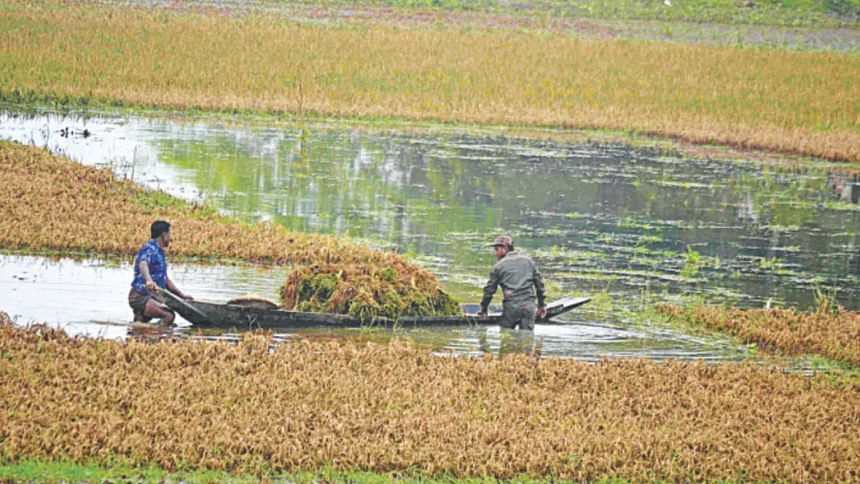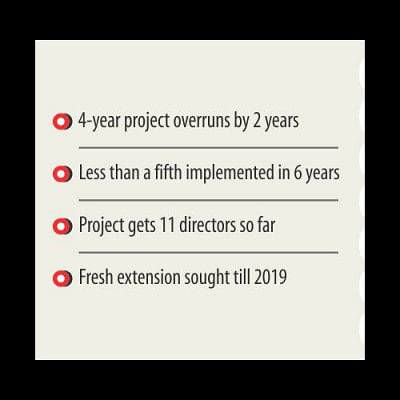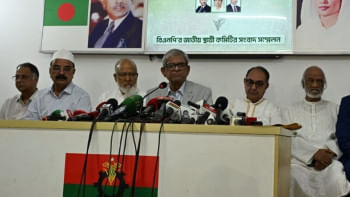Haor project put on ice

In the country's northeastern haor region, people continue to live at nature's mercy. Every year, pre-monsoon floods submerge vast swathes of their land, destroying the only crop they can grow -- Boro rice.
And after years of the flashfloods, triggered by rain and onrush of water from the hills, the government finally took up a project in 2011 to save 29 upazilas of Sylhet, Sunamganj, Moulvibazar, Habiganj, Kishoreganj and Netrakona from the havoc.

The main objectives of the Tk 704 crore priority project were to build and repair flood protection embankments and improve drainage system in the haor area that experiences 12,000 millimetres of yearly rainfall on average.
That project has now overrun by two years, achieving almost nothing.
Recently, Bangladesh Water Development Board, tasked with implementing the project, informed a planning ministry appraisal meeting that it could spend less than a fifth (Tk 138 crore or 19.6 percent) of the project money.
In its stipulated four-year term, the BWDB had spent 17.89 percent of the budget.
And this sorry state of the project comes to the fore at a time when the country's northeast region is bearing the brunt of a devastating flashfloods that struck very early into the pre-monsoon season (in late March), wiping out a million tonnes of unripe Boro rice.
Bangladesh's targeted Boro rice output was 1.9 crore tonnes this season. The crop loss threw out a challenge to the government, forcing it to go for rice import for the first time in six years.
At the August 8 appraisal meeting held in the capital, the Planning Commission noted that people living in the haor belt had to suffer losses following the flashfloods due to long delay in implementing the project -- titled “Pre-monsoon Flood Protection and Drainage Improvement in Haor Area”.
With the project to protect the haor people progressing at a snail's pace, BWDB officials, at the meeting, sought a fresh extension till June 2019 for its implementation.
As questions were raised over the delay in project implementation, the officials came up with “excuses”, saying they get a brief dry season (January-March) in the haor zone for doing the project's physical work, said meeting sources.
They also claimed that they did not receive funds as per the annual development programme's (ADP) financial allocations.
Although the project was supposed to build 39 drainage regulators, only 15 could be constructed while not a single of the 29 drainage outlets, 35 causeways and 22 irrigation inlets could be set up.
The project was supposed to re-excavate 333km of canals whereas in reality, work on little over 45km has been accomplished.
Of the 116km of river dredging work to be covered by the project, the BWDB could complete just 3.79km.
The project, however, has achieved a little better progress in construction and repair of embankments. Of 20 million cubic metres of submergible embankments, the BWDB worked on 9.6 million cubic metres.
Asked about the reasons behind the delay in project implementation, K M Anwar Hossain, who has been the project director since last June, said they were not receiving yearly funds properly.
He claimed that they lacked manpower for looking after the monitoring work and had limited time (January-March) for the physical work as haor areas usually remain under water during the rest of the year.
Water Resources Ministry Joint Chief Montu Kumar Biswas, however, said funds were released based on requirements placed from the field.
Citing an example, he said the project in question could utilise just Tk 40 crore in the last fiscal year, against an allocation of Tk 100 crore.
Abu Bakar Siddiqui, an executive engineer working with the project, said 36 of 52 haor areas under the project were in Sunamganj.
He claimed that proper monitoring work was not possible in some remote areas due to a lack of manpower.
Abu Bakar also said project officials were transferred all too frequently, even before they could understand anything about the work.
Water resources ministry sources said the BWDB's chief engineer for Sylhet Division was ex-officio project director of the project.
A planning ministry official said the project had seen 11 project directors in the last six years.
The official, who wished not to be named, blamed the frequent change of the director for the delay in the project implementation, and said the officials tried to get themselves transferred through lobbying as they had to work in remote areas.
Such negligence by BWDB officials dealing with the fate of some 60 lakh hoar people is not an isolated one.
Just five days before the August 8 appraisal meeting, some lawyers in the worst-hit Sunamganj sued 140 people, including BWDB officials and contractors, for their negligence and irregularities in construction of embankments that collapsed in flashfloods in April.
On July 2, the Anti-Corruption Commission filed a case with Sunamganj Model Police Station, accusing 61 people, including BWDB officials and contractors, of “purposeful mismanagement” and corruption in building dams in the district.
Local Jubo League leader Khairul Huda, one of the contractors, was arrested at Hazrat Shahjalal International Airport on this Wednesday.
Earlier, the anti-graft watchdog arrested suspended BWDB executive engineer Afsar Uddin and contractor Bachhu Mia in the capital's Motijheel area for irregularities in construction of dams in the same district.
The ACC also asked the government to take stern action against water resources secretary, BWDB director general and 14 other officials for “gross negligence in discharging their duties”.
On May 2, three BWDB engineers were suspended over similar allegations.


 For all latest news, follow The Daily Star's Google News channel.
For all latest news, follow The Daily Star's Google News channel. 




Comments